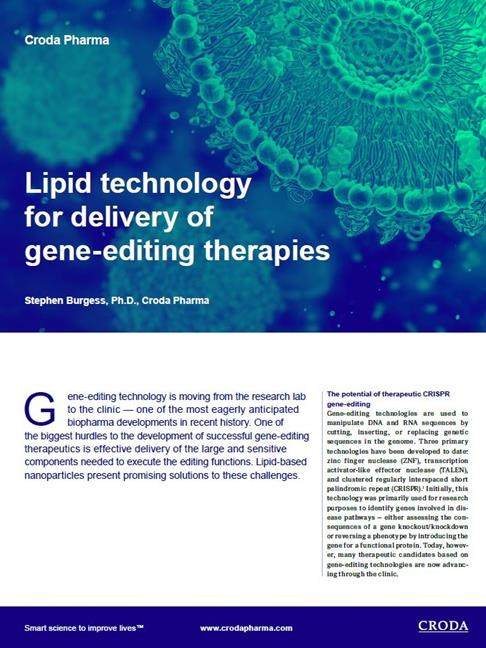The future of mRNA delivery: Advancements in engineering lipid nanoparticles for enhanced intracellular delivery through inhalation
Messenger RNA (mRNA) has played a crucial role in recent vaccine developments and is at the forefront of much current medical research. Traditionally. the delivery of mRNA systemically via lipid nanoparticles (LNPs) innately results in LNP accumulation in the liver limiting the access to other organs. The ability to target LNPs for delivery of mRNA to other organs through new routes of administration opens the door to new therapeutic applications, such as inhaled delivery to the lung epithelium for the treatment of pulmonary diseases. We will examine recent developments in the LNP-mediated delivery of mRNA through inhalation in this blog post and discuss how they could affect future treatment of pulmonary diseases.
The challenge of inhaled mRNA delivery
A recent paper in ACS Nano identified three primary challenges associated with LNP-based inhaled delivery of mRNA 1 Nebulizers produce a tremendous amount of force resulting in the potential loss of nanoparticle and mRNA integrity. 2 LNPs can be prevented from reaching the lung epithelia due to airway mucus. 3 The inability of mRNA to escape the endosome leads to bioavailability issues. Do these challenges mark the end of the road? Not even close! Keep reading to learn how researchers at Oregon State University developed LNP formulations to overcome these limitations and successfully delivery mRNA to the lungs.
Engineering lipid nanoparticles for inhaled delivery
Traditional LNPs are composed of four lipid components including an ionizable lipid, a PEG lipid, a structural lipid, and cholesterol. Each plays a distinct role in the efficacy of the LNP to deliver mRNA. While many delivery applications focus on the properties of the ionizable lipid, inhaled delivery turns its focus to the PEG lipid and sterol component. Inhaled delivery through nebulization requires adequate particle stabilization to withstand the strong force of the process, as well as adequate endosomal escape of the LNP. With this in mind, researchers at Oregon State University turned their attention to PEG lipid component which is the primary driver of particle stability, and the sterol component found to play an important role in endosomal escape. To this end, the researchers examined several LNP formulations to identify successful combinations that would permit nebulization and endosomal escape of mRNA to the lung epithelia. So, what did they find?
The role of PEG concentration and β-Sitosterol in LNP formulations
Through a series of in vitro and in vivo experiments, the researchers found that modulating PEG concentration and substituting β-sitosterol for cholesterol resulted in successful delivery of mRNA to the lungs through nebulization. Increasing the PEG concentration resulted in a more stable and smaller LNP for nebulization allowing the particle to withstand the shear stress of the process; however, increasing the concentration beyond 5.5% had an impact on mRNA encapsulation efficiency and transfection. So, the balance is delicate.
It has previously been noted that substitution of cholesterol with β-sitosterol increases mRNA transfection efficiency by 200% by improving the endosomal escape of the LNP. Building on this previous research, the OSU team utilized β-sitosterol in place of cholesterol to evaluate if this substitution could compensate for the loss of transfection in the high-concentration PEG particles. Indeed, in vitro and in vivo data revealed that LNPs containing sitosterol showed a higher transfection efficiency and were resilient to shear stress during nebulization resulting in mRNA delivery to the lungs through inhalation of nebulized LNPs.
The potential of inhalable mRNA therapy
The use of inhalable mRNA therapy has the potential to completely alter how respiratory disorders are treated. Lung cancer, pulmonary arterial hypertension, and cystic fibrosis are just a few of the conditions that it could be used to treat. A functioning copy of the CFTR gene, for instance, might be delivered to the lungs via inhalable mRNA therapy, reversing the genetic defect that causes cystic fibrosis.
Inhalable mRNA treatment for pulmonary arterial hypertension might provide proteins that could loosen the blood arteries and increase blood flow to the lungs. Inhalable mRNA treatment for lung cancer may provide proteins that prompt the immune system to attack cancer cells.
Conclusion
The formulation criteria for inhaled delivery of LNPs is unique versus other administration routes. The research presented brings us one step closer to opening LNP technology to a whole host of new applications and diseases. Specifically, inhalable mRNA therapy has the potential to revolutionize the treatment of respiratory ailments. As research in this area progresses, it is exciting to consider the promise that inhalable mRNA treatment holds for the future of medicine.
As innovation occurs in delivery formulations, Avanti is the perfect partner to supply the lipids to make your project a success – including a variety of PEG lipids and β-sitosterol. Not working on inhaled delivery? No problem! Our team of formulation and lipid synthesis experts are here to innovate with you and tackle challenges head on.
1,2,3 https://pubs.acs.org/doi/full/10.1021/acsnano.2c05647
WHITEPAPER: Lipid technology for delivery of gene-editing therapies

